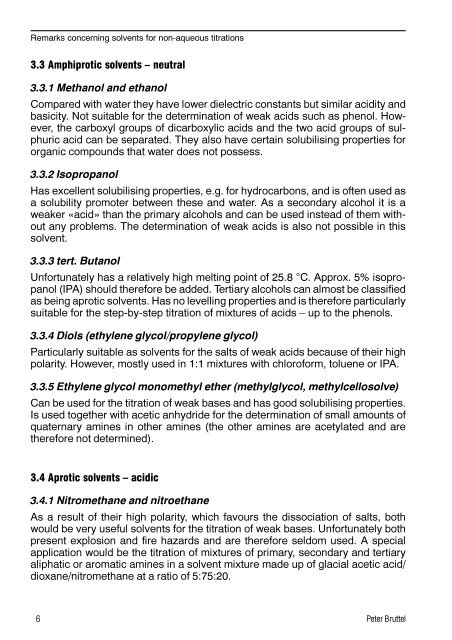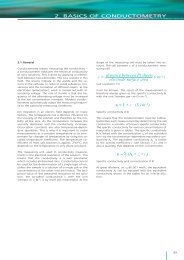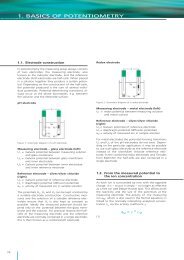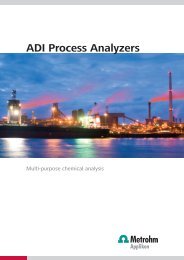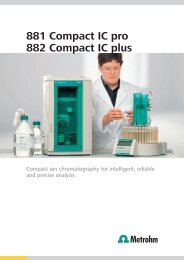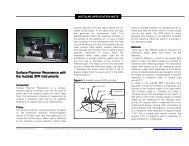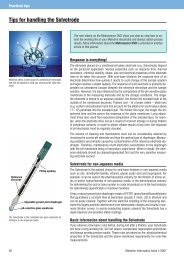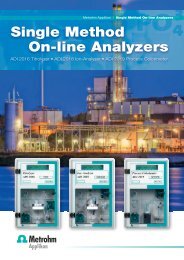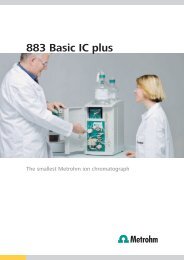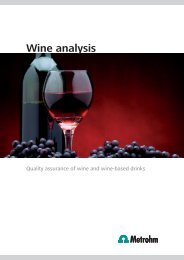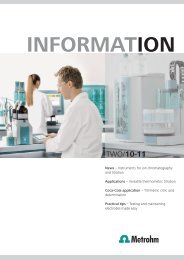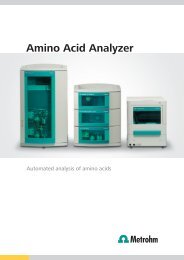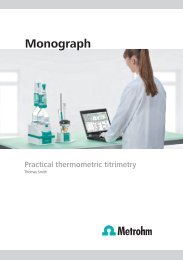Monograph - Metrohm
Monograph - Metrohm
Monograph - Metrohm
Create successful ePaper yourself
Turn your PDF publications into a flip-book with our unique Google optimized e-Paper software.
Remarks concerning solvents for non-aqueous titrations3.3 Amphiprotic solvents – neutral3.3.1 Methanol and ethanolCompared with water they have lower dielectric constants but similar acidity andbasicity. Not suitable for the determination of weak acids such as phenol. However,the carboxyl groups of dicarboxylic acids and the two acid groups of sulphuricacid can be separated. They also have certain solubilising properties fororganic compounds that water does not possess.3.3.2 IsopropanolHas excellent solubilising properties, e.g. for hydrocarbons, and is often used asa solubility promoter between these and water. As a secondary alcohol it is aweaker «acid» than the primary alcohols and can be used instead of them withoutany problems. The determination of weak acids is also not possible in thissolvent.3.3.3 tert. ButanolUnfortunately has a relatively high melting point of 25.8 °C. Approx. 5% isopropanol(IPA) should therefore be added. Tertiary alcohols can almost be classifiedas being aprotic solvents. Has no levelling properties and is therefore particularlysuitable for the step-by-step titration of mixtures of acids – up to the phenols.3.3.4 Diols (ethylene glycol/propylene glycol)Particularly suitable as solvents for the salts of weak acids because of their highpolarity. However, mostly used in 1:1 mixtures with chloroform, toluene or IPA.3.3.5 Ethylene glycol monomethyl ether (methylglycol, methylcellosolve)Can be used for the titration of weak bases and has good solubilising properties.Is used together with acetic anhydride for the determination of small amounts ofquaternary amines in other amines (the other amines are acetylated and aretherefore not determined).3.4 Aprotic solvents – acidic3.4.1 Nitromethane and nitroethaneAs a result of their high polarity, which favours the dissociation of salts, bothwould be very useful solvents for the titration of weak bases. Unfortunately bothpresent explosion and fire hazards and are therefore seldom used. A specialapplication would be the titration of mixtures of primary, secondary and tertiaryaliphatic or aromatic amines in a solvent mixture made up of glacial acetic acid/dioxane/nitromethane at a ratio of 5:75:20.6 Peter Bruttel


